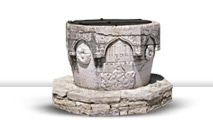
- Sečovlje Salt Pans - Dragonja River Valley
- Sv. Peter - Nova vas - Padna
- Pomjan - Nature Park: Karst Edge - Socerb
- Črni Kal - Osp - Kubed
- Momjan - Grožnjan - Pietrapelosa - Mirna
- Baštija - Kostanjica - Parenzana
- Oprtalj - Završje - Livade - Zrenj
- Istarske toplice - Motovun Forest - Višnjan
- Cave Mramornica - Feštini Kingdom - Cave Baredine
- Lim Bay - Kloštar - Kontija - Dvigrad
- Kanfanar - Bale - Palud - Vodnjan -Islands Brijuni - Fažana
- Svetvinčenat - Tinjan - Pićan - Gračišće
- Belaj - Šumber - Kožljak - Paz
- Čepićko Field - Kršan - Boljun Castle - Lupoglav
- Plomin - Kvarner Gulf - Brseč
- Nature park Učka - Mošćenice
Oprtalj - Završje - Livade - Zrenj
Završje
Driving down the road towards Završje, the syntagm magical Istria assumes its full meaning: it is truly a breathtaking view. In the foreground is the medieval town rising on a cliff above the Mirna Valley, and in the distance behind it is Motovun on the other side of the river, on another hill, as if afloat. This is where the story about the fortifications, about life above the Mirna River, about the trade that took place in its ports and navigability deep into the interior, the mystical quality of Motovun forest and centennial battles for possession, comes to life.
The town developed on the site of a prehistoric hill-fort, while life in Antiquity is testified by inscriptions and reliefs.
It was first mentioned in the 11th c. in the deed of gift of the Patriarch of Aquileia. Already then it was some kind of a fortified structure that was reconstructed and reinforced during the administration of different rulers, from the Counts of Gorizia, to the Habsburgs, the Devins and the Austrian Empire. The most extensive works were carried out in the 16th c. when Završje was purchased with Kostanjica at auction and came into possession of the Contarini family.
It was protected by a double ring of walls, remains of which are partly visible even today. The southern town gate has also been preserved. Unfortunately, only by its monumental heritage can this nearly deserted town speak of the one-time rich and opulent life of its owners. The Parish Church of the Nativity of the Blessed Virgin Mary from the 18th c. has several altar palas and organ by G.B. Piaggi. The Church of Our Lady of the Rosary was once the parish church and dates from the 16th c. Other churches are St. Roch from the 16th c., SS. Primus and Felician near the village Čirkoti, from the 12th c. with two layers of frescoes, and the Romanesque Chapel of St. George from the 12th c., within the remains of the village of the same name, not far from Završje.
Print page Send to a friend

















